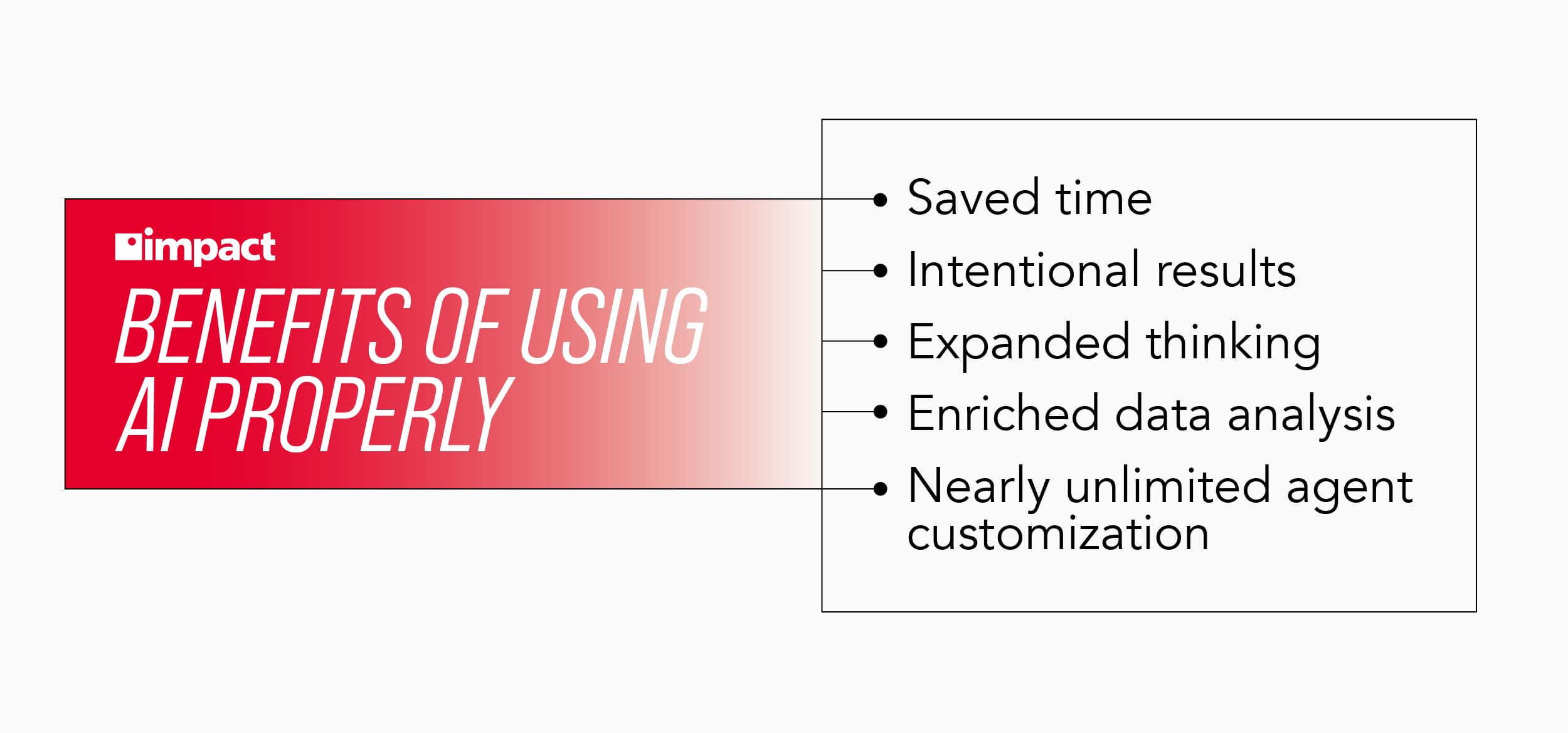From writing assistants to smart schedulers, AI is quietly, but quickly, reshaping how we work. Properly integrating AI into your workflows goes much further than simply using ChatGPT.
This isn’t about replacing jobs or automating everything. It’s about identifying the parts of your workflow that slow you down or pull you away from higher-value work—and letting AI handle those.
The key is to start with clear, manageable use-cases. You don’t need to overhaul your entire workflow or invest in enterprise-level solutions off the bat. You just need to know where to look, what to try, and how to build from there.
In this post, we’ll walk through a few practical ways to start using AI to save time and increase productivity. Each one is designed to be accessible, scalable, and immediately useful—whether you’re working solo, managing a team, or collaborating across departments.
For more information on how AI can be integrated into your workflows to increase productivity, watch Impact’s webinar, Lessons Learned from Incorporating AI into Business Processes.
Learning to Work with AI as a Partner
AI works best when it’s treated like a teammate, not a tool. That means understanding what it’s good at, what it’s not, and how to collaborate with it in a way that actually improves your workflow. The goal isn’t to hand off everything—it’s to elevate your work as a whole.
Start by reframing how you think about AI. It’s not just a piece of software; it’s a system that can learn patterns, surface insights, and handle repetitive tasks with speed and consistency. But like any teammate, it needs context. The more clearly you define what you want it to do, the better it performs.
For example, if you’re using an AI writing assistant, don’t just ask it to “write a blog post.” Give it a headline, a target audience, a tone, and a few key points. Treat it like a junior writer who needs direction. You’ll get better results, faster.
This mindset shift also helps you avoid common frustrations. AI isn’t magic—it’s logic. If it gives you something off-base, it’s usually because the input was vague or the task wasn’t well-defined. Learning to work with AI means learning to communicate clearly and iteratively.
Here are a few ways to start building that partnership:
- Start with tasks you already understand well. If you know how to write a summary or sort data manually, you’ll be better equipped to guide AI through it.
- Give feedback. Many tools let you refine outputs or rate responses. Use that to teach the system what “good” looks like.
- Stay in the loop. Don’t set it and forget it. Review what AI produces, tweak it, and use it as a jumping-off point—not a final product.
The more you engage with AI as a collaborator, the more value you’ll get out of it. And over time, you’ll start to see patterns—places where it consistently saves you time, improves quality, or helps you move faster.
That’s when it stops being a novelty and starts becoming a core part of how you work.
Creating Use-Cases and Building Function
Once you've started experimenting with AI, the real value comes from turning those experiments into repeatable, useful processes. This is where use-cases come in—not as abstract possibilities, but as concrete ways AI can support your work.
Start by looking at the tasks that slow you down or require repetitive effort. These are prime candidates for AI support. The goal is to build small systems that save time and reduce friction.
In the next few sections, we’ll walk through three practical examples that show how AI can be embedded into your daily work—not just as a tool, but as a functional part of your productivity stack.
1. AI-Powered Meeting Notes and Summaries
Meetings are essential, but the follow-up work, like capturing notes, identifying action items, and sharing summaries, can eat up valuable time. AI tools are changing that by turning real-time conversations into structured, shareable content.
These AI meeting assistant tools can:
- Transcribe meetings as they happen
- Highlight key decisions and next steps
- Generate clean, editable summaries within minutes
This isn’t just about saving time; it’s about improving clarity and accountability. When everyone has access to the same summary, there’s less room for miscommunication and more space for focused execution.
Not only that, but by letting AI take notes and spin up the summary, live attendees can focus on the substance of the meeting, not note keeping.
2. AI for Data Sorting and Analysis
When you're working with large volumes of data like survey responses, customer feedback, and performance metrics, manual sorting can be slow and prone to errors. AI tools can take over the grunt work, helping you surface insights faster and with more consistency.
In the data analytics space, AI tools offer features that:
- Categorize survey responses even if they’re open-ended
- Flag anomalies or outliers in datasets
- Generate summaries or visualizations for reporting
- Identify data trends
- Process big data
This kind of support is especially useful for content teams analyzing engagement data or feedback from multiple channels. Instead of spending hours tagging and tallying, you can focus on interpreting results and making strategic decisions.
The key is to define what you're looking for, whether it's sentiment, patterns, or performance indicators—and let the AI handle the sorting and report pulling.
3. Stringing Together AI Workflows
AI becomes exponentially more powerful when you connect tools into a sequence—each one handling a piece of the process, passing the output to the next. This kind of workflow turns scattered tasks into streamlined systems.
For example:
- A presentation outline is fed to an AI tool, which drafts a script for the presenter
- That script is fed to a second AI tool that turns it into an outline for a deck
- The deck outline is then given to a final AI tool that pulls together assets and creates the whole presentation
You don’t need to be technical to build these chains. Many modern platforms offer drag-and-drop interfaces or built-in automation features that let you link actions together with minimal setup.
Stringing these functions together results in more time spent on creative, strategic, high-value work. Once you’ve built a few of these workflows, you’ll start spotting new opportunities to automate across your day.
Starting Small with AI for Productivity Wins
While you’ll want one eventually, you don’t need a full-scale AI strategy out of the gate to start seeing results. In fact, the most effective way to build momentum is to start small by testing simple tools on everyday tasks and learning what works for your workflow.
Look for low-risk, high-reward opportunities:
- Build an email agent that can filter, sort, and prioritize your emails before offering you a first draft
- Use AI to help you brainstorm on your creative projects or offer critiques on a pitch
- With a private AI environment, feed it some data and let it put together a report for you to analyze
These small wins add up. They free up mental space, reduce context switching, and give you a feel for how AI fits into your rhythm. More importantly, they build confidence.
Once you see how AI can handle the basics, it’s easier to imagine how it might support bigger, more complex projects. The goal isn’t perfection—it’s progress. Start with one tool, one task, and one improvement. Then build from there.
Keeping Ethics and Sustainability in Mind
As AI becomes more embedded in daily workflows, it’s important to pause and consider the broader impact—on people, on systems, and on the planet. Productivity gains are valuable, but they shouldn’t come at the cost of ethical clarity or long-term sustainability.
Here are a few principles to keep in mind:
- Transparency matters. Know what your AI tools are doing with your data. Read the fine print, understand the privacy policies, and make sure your team is aligned on what’s being shared and stored.
- Bias is real. AI systems learn from data and that data often reflects human bias. Be critical of outputs, especially when using AI for decision-making, hiring, or content generation. A second set of human eyes is still essential.
- Sustainability isn’t just a buzzword. AI models require significant computing power, which translates to energy use. Opt for tools that are optimized for efficiency and consider whether every task truly needs an AI solution.
- Human oversight is non-negotiable. AI should support—not replace—human judgment. Keep people in the loop, especially when the stakes are high or the context is nuanced.
Building ethical and sustainable AI habits now ensures that your productivity gains don’t come with unintended consequences later. It’s not just about what AI can do—it’s about how we choose to use it.
Wrapping Up on Boosting Productivity with AI
AI isn’t a silver bullet, but it is a powerful lever. When used intentionally, it can help you reclaim time, reduce friction, and sharpen your focus on the work that matters most.
The key is to treat AI as a partner, not a replacement. Start small, build use-cases that fit your workflow, and stay mindful of the ethical and environmental implications. The goal isn’t to automate everything, it’s to automate the right things.
Whether you're summarizing meetings, sorting data, or connecting tools into smart workflows, each step forward builds a more efficient, thoughtful way of working. And as the tools evolve, so will the opportunities to do more with less effort.
Learn more about AI integration in Impact’s webinar, Lessons Learned from Incorporating AI Into Business Processes.



